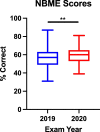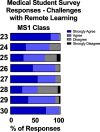Medical student exam performance and perceptions of a COVID-19 pandemic-appropriate pre-clerkship medical physiology and pathophysiology curriculum
- PMID: 36460995
- PMCID: PMC9716147
- DOI: 10.1186/s12909-022-03907-5
Medical student exam performance and perceptions of a COVID-19 pandemic-appropriate pre-clerkship medical physiology and pathophysiology curriculum
Abstract
Background: Medical schools were compelled to abruptly transition pre-clerkship curricula to remote learning formats due to the emergence of the Coronavirus Disease 2019 (COVID-19) pandemic. We evaluated student perceptions of remote learning, exam performance, and utilization of third-party learning resources to assess the implementation of a newly developed pandemic-appropriate physiology curriculum.
Methods: This was an observational study based on a survey conducted in the Spring of 2021 at the University of California, Irvine, School of Medicine (UCISOM). This study aimed to assess first (MS1) and second year (MS2) medical students' perceptions of satisfaction, support, academic performance, and connectedness before and during the COVID-19 pandemic. The MS1 class began medical school during the first year of the COVID-19 pandemic, whereas the MS2 class did so prior to the start of the pandemic. A survey instrument was developed and validated to identify the impact remote learning had on student self-perceptions of the Medical Physiology and Pathophysiology course. Surveys were distributed to all students and responses were collected on a voluntary basis. Exam scores on a customized National Board of Medical Examiners (NBME) physiology shelf exam were also compared to objectively identify how the remote curriculum during the pandemic impacted academic performance.
Results: Of 204 students enrolled, 74 responses were analyzed, with 42 MS1 (40% of MS1s) and 32 MS2 (31% of MS2s) responses. Overall, MS1s and MS2s were satisfied with the curriculum they received (95 and 97% respectively) and the school's support of their concerns (86 and 100% respectively). Notably, only 50% of MS1s felt connected to their peers, compared to 94% of MS2s. Lecture attendance and self-perception of their academic performance were similar between both classes. Interestingly, the intra-pandemic class's NBME exam average in 2020 (60.2% ± 8.9, n = 104) was significantly higher than the pre-pandemic class average in 2019 (56.8% ± 11.3, n = 100). Both classes primarily used course materials over third-party learning resources. An additional set of survey questions distributed only to the MS1 class found that the majority of MS1s reported minimal barriers with regards to accessibility, including internet connectivity, study-conducive environments, and balancing family commitments. Overall, pre-clerkship medical students had positive perceptions of the newly developed pandemic-appropriate physiology curriculum.
Conclusions: Changes to the pre-clerkship physiology curriculum during the COVID-19 pandemic were met with overall satisfaction from the students and an increase in NBME scores. More attention to student connectedness is needed to improve how remote learning can be best optimized into future curricula development.
Keywords: COVID-19; Physiology; Pre-clerkship; Remote learning; Undergraduate medical education; Virtual curriculum.
© 2022. The Author(s).
Conflict of interest statement
I declare that the authors have no competing interests as defined by BMC, or other interests that might be perceived to influence the results and/or discussion reported in this paper.
Figures









Similar articles
-
Analysis of Pre-clerkship Medical Students' Perceptions and Performance During the COVID-19 Pandemic.Med Sci Educ. 2023 Jan 9;33(1):147-156. doi: 10.1007/s40670-022-01723-6. eCollection 2023 Feb. Med Sci Educ. 2023. PMID: 36688011 Free PMC article.
-
Resilience in Medical Education: Examining the Effects of the COVID-19 Pandemic on Pre-clerkship Curriculum Outcomes and Learner Perceptions at the University of Hawai'i John A. Burns School of Medicine.Hawaii J Health Soc Welf. 2025 Jan;84(1):4-9. doi: 10.62547/IJCZ9506. Hawaii J Health Soc Welf. 2025. PMID: 39790096 Free PMC article.
-
Effects of Recorded versus Live Teleconference Didactic Lectures on Medical Student Performance in the Surgery Clerkship.J Surg Educ. 2023 Feb;80(2):228-234. doi: 10.1016/j.jsurg.2022.09.017. Epub 2022 Oct 11. J Surg Educ. 2023. PMID: 36241483 Free PMC article.
-
Learning together: a narrative review of external resources for medical education through a shared student-faculty lens.Ann Med. 2025 Dec;57(1):2483971. doi: 10.1080/07853890.2025.2483971. Epub 2025 Mar 28. Ann Med. 2025. PMID: 40152754 Free PMC article. Review.
-
Exploring students' [pre-pandemic] use and the impact of commercial-off-the-shelf learning platforms on students' national licensing exam performance: A focused review - BEME Guide No. 72.Med Teach. 2022 Jul;44(7):707-719. doi: 10.1080/0142159X.2022.2039380. Epub 2022 Mar 10. Med Teach. 2022. PMID: 35271398 Review.
Cited by
-
Collaborative Learning Communities With Medical Students as Teachers.J Med Educ Curric Dev. 2023 Jun 20;10:23821205231183878. doi: 10.1177/23821205231183878. eCollection 2023 Jan-Dec. J Med Educ Curric Dev. 2023. PMID: 37362582 Free PMC article.
-
The Impact of Tele-Education on Family Medicine Clerkship Students' Learning Outcomes.Fam Med. 2023 Oct;55(9):616-619. doi: 10.22454/FamMed.2023.410835. Epub 2023 Jul 24. Fam Med. 2023. PMID: 37540529 Free PMC article.
References
-
- Gordon M, Patricio M, Horne L, Muston A, Alston SR, Pammi M, Thammasitboon S, Park S, Pawlikowska T, Rees EL, et al. Developments in medical education in response to the COVID-19 pandemic: a rapid BEME systematic review: BEME guide no. 63. Med Teach. 2020;42(11):1202–1215. doi: 10.1080/0142159X.2020.1807484. - DOI - PubMed
Publication types
MeSH terms
LinkOut - more resources
Full Text Sources
Medical
Miscellaneous

